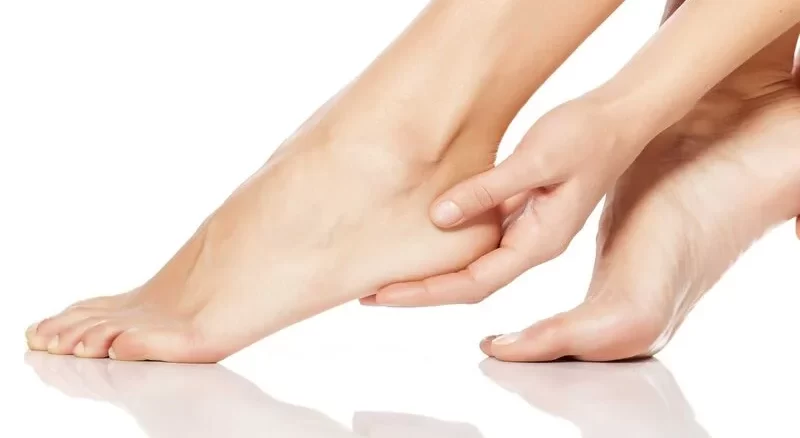Heel spur treatment is one of the most frequently asked questions. Before going to the treatment, we must first diagnose this disease and ensure that your problem is heel spurs. In this article, we will discuss the treatment points of this problem and its diagnosis.
What is a heel spur?
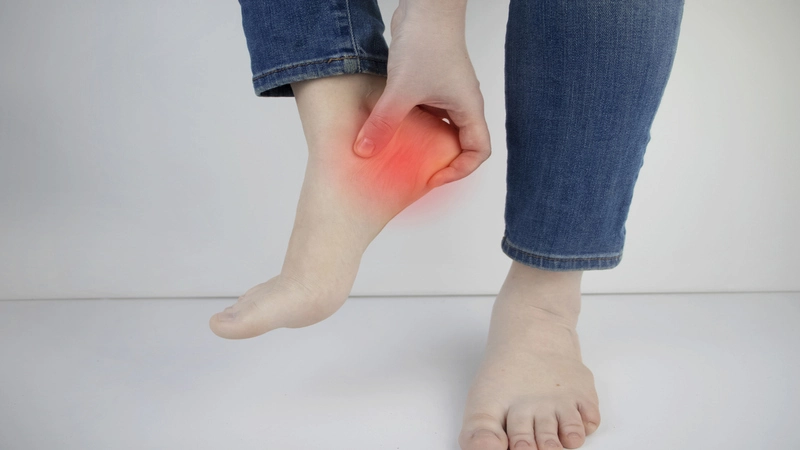
A heel spur (osteophyte or bony appendage) is a small bony appendage or set of bony appendages that develops on the back of the heel or under it.
Heel spurs can be painful or painless. Patients often confuse heel spurs with another disease called plantar fasciitis. In this condition, the band of tissue stretching from the sole of the foot to the heel, i.e., the plantar fascia, becomes inflamed and leads to pain in the sole of the foot and heel. In fact, many people never notice the existence of a heel spur.
In X-ray images, about 70% of patients with plantar ligament inflammation have heel spurs. A heel spur is likely to form when the body attempts to repair repeated injuries by building extra bone at the injury site. Plantar ligament inflammation is usually the result of such injuries.
You should pay attention to this disease, and if this problem occurs, you need to go through the treatment of Posterior Heel Spur in Dubai.
Symptoms of heel spurs
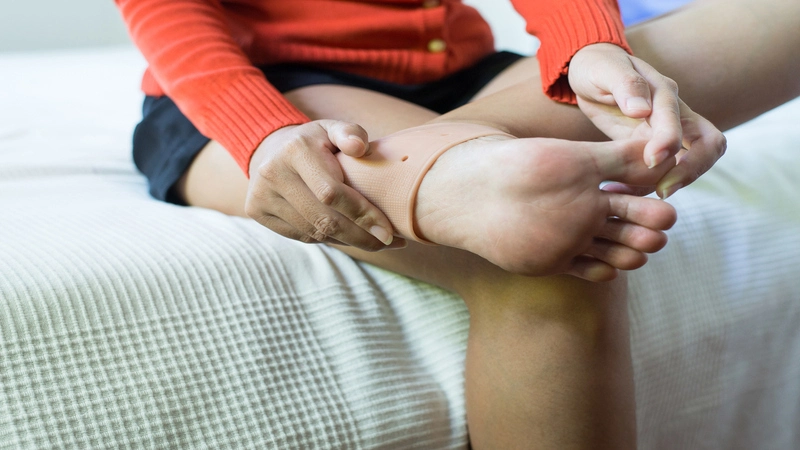
Most people with thorny heels do not know about the existence of this condition. In radiographic images, the presence of heel spurs is determined, but sometimes this disease can cause intermittent and chronic pain, which worsens when running and walking. In such situations like this a special foot surgeon in Dubai
Of course, the cause of heel spur pain is not the damage to the soft tissue of the heel, which is called fascia. Symptoms of heel spurs include:
- A feeling of pain under the heel, which is like a sharp object sinking into the leg.
- Severe pain is felt when waking up.
- Feeling severe pain after sitting for a long time.
- A feeling of severe pain that decreases during the day and intensifies as the night approaches.
- A feeling of excessive tiredness of the legs at night
- A sense of pain under the heel when walking on hard surfaces
So, never forget to visit an ankle surgeon in Dubai whenever you diagnose these symptoms.
✔️ Read More: Electromyography; Definition and Benefits
Why do we get heel spurs?

Plantar fasciitis is an overuse injury. Frequent and excessive stretching of this ligament, inflammation, and possible thickening cause heel spurs. Plantar fascia loses strength and flexibility as a result of thickening. This is common in sports that involve running, dancing, or jumping.
Remember to visit a specialist doctor immediately whenever you have this disease. Specialists will help you in treating this disease and also the treatment of Claw Toe.
Overpronation
Overpronation means excessive inward rotation of the foot or significant flattening of the foot. Runners with overpronation are prone to this problem because the flatter the sole of the foot, the more the plantar fascia is stretched.
The high arch of the foot
This problem is also common in people who have high arches because the soles of the feet do not have impact properties and cannot adapt to different surfaces.
Stiffness of leg muscles
One of the common causes of inflammation of the plantar fascia is the stiffness of the calf muscles, which leads to inward rotation or chronic and rapid pronation.
Improper shoes
Walking for long periods in shoes that do not support the soles of the feet well can be damaging and can cause heel spurs. Suitable shoes for patients with plantar fasciitis have flat soles, laces and support the foot’s arch well.
Overweight
Overweight people are more prone to heel spurs than others due to the effect of extra weight on the soles of the feet.
Previous injuries
Suppose the previous stretching of the plantar fascia or injury to the sole of the foot has not been treated well. In that case, the possibility of inflammation of the plantar fascia will be high.
Arthritis
Excessive use of slippers and arthritis are other causes of heel spurs.
✔️ Read More: What Is Physiotherapy? Benefits and Applications
Risk factors for heel spurs
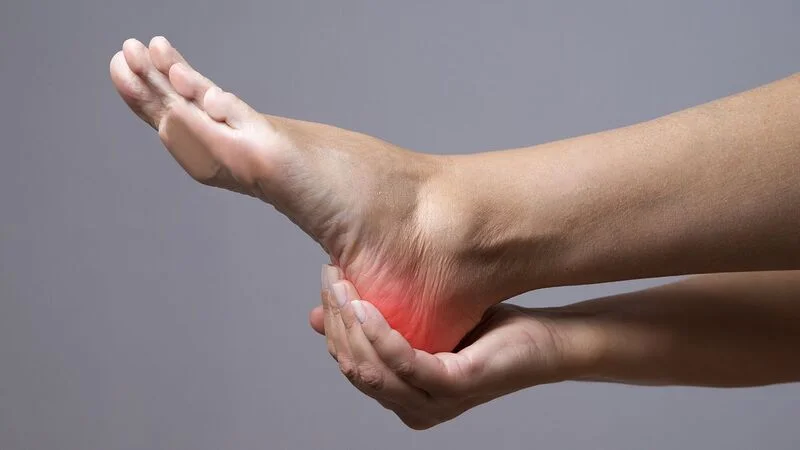
Even if plantar fasciitis develops for no apparent reason, some factors can increase the disease’s risk. They include:
1- Age
Swelling of the soles of the feet is more common between the ages of 40 and 60.
2- Certain types of sports
Activities that stress your heel and its connective tissue, such as long-distance running, ballet, and aerobics, can contribute to plantar fasciitis.
3- Foot mechanics defects
Flat feet, large plantar dimpling, and abnormal walking patterns can affect how weight is distributed when standing and can put more pressure on the plantar fascia.
4- Obesity
Extra weight puts extra stress on your plantar fascia.
5- Heavy jobs
Factory workers, teachers, and others who spend most of their working hours walking or standing on hard surfaces can injure the plantar fascia.
✔️ Read More: Haglund’s Deformity; How To Diagnose and Treat It
How to prevent heel spurs?

The most important and main way to prevent heel spurs is to use shoes suitable for physical activity. Standard shoes prevent heel strikes when constantly hitting the ground.
The important thing is to warm up your body before doing heavy physical activities and then do the exercises. It is also necessary and important to do stretching exercises during the day.
Avoid wearing shoes without arches and flats or very high heels for long periods.
Other things that increase the risk of heel spurs are overweight and obesity. Weight loss will be very effective and helpful in treating heel spurs.
In short, the ways to prevent heel spurs are:
- Use appropriate shoes
- Warming up before exercise
- Doing stretching exercises during the day
- Keeping fit
What are the side effects of heel spurs?
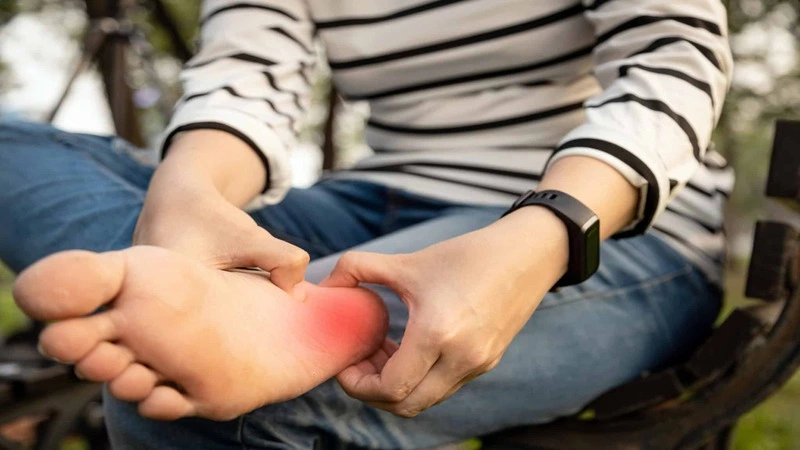
Untreated plantar fasciitis may lead to chronic heel pain that interferes with your regular activities. Changing your walking pattern to relieve plantar fasciitis pain may lead to foot, knee, hip, or back problems.
✔️ Read More: What Is a Ligament? Types of Ligaments and the Causes of Their Injury
Diagnosis of heel spurs
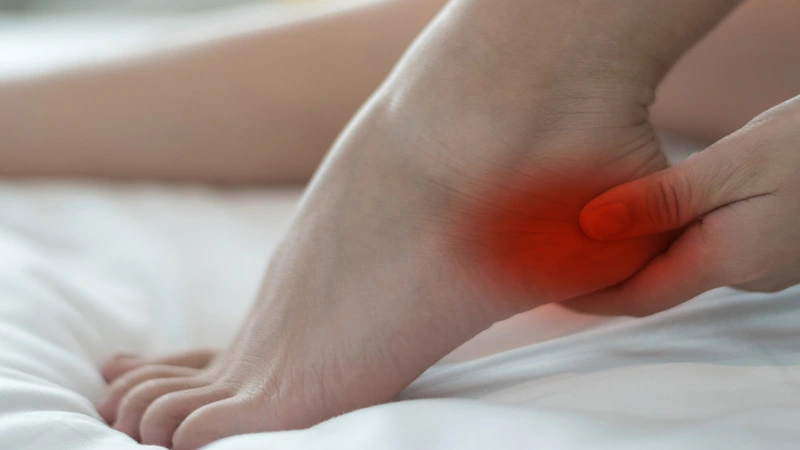
Heel spurs or plantar fasciitis are diagnosed based on your medical history and physical examination. During the examination, the doctor will check the sensitive areas of your foot. The location of your pain can help determine the cause.
Heel spur imaging tests
Your doctor may suggest an X-ray or MRI. In the X-ray, a piece of bone can protrude from the heel bone (thorn). In the past, these bony spurs were often blamed for heel pain and were surgically removed. But many people with heel spurs do not have heel pain.
How to treat heel spurs?
Although there is no unique treatment for plantar fasciitis, several methods are used to relieve and treat the heel. Heel spur treatment methods are usually divided into short-term and long-term groups. Effective long-term heel spur treatment depends on correcting the cause and treating the symptoms.
✔️ Read More: What Is a Tendon? Types of Tendons and the Causes of Their Damage
Home treatment
In the home treatment of heel spurs, it is recommended that the patient does not put the foot on the ground. Also, to reduce swelling, put ice on the soles of the feet 3 to 4 times a day, for 15 to 20 minutes each time.
Reducing or changing exercise activities can also be helpful. Putting the right insoles in the shoes and stretching exercises also help relieve the pain.
Rest and ice
Rest until the pain is completely relieved. If you have to walk, wear comfortable sports shoes or use special adhesive. A gelatin-like heel pad is also effective in relieving symptoms.
Use ice or cold therapy to reduce pain and inflammation. If the pain is severe, you can use the cold therapy method every hour for 10 minutes during the first 24 to 48 hours of pain. Gradually reduce the number of times to 3 times a day as the symptoms disappear.
Non-steroidal anti-inflammatory drug
Medicines such as ibuprofen or naproxen reduce the pain and inflammation of heel spurs. But taking the drug for more than one month should be done with the doctor’s permission.
Massage
Sports deep tissue massage techniques reduce stiffness and internal pressure and stretch the calf muscles and plantar fascia. The patient himself can also perform the massage by rolling a frozen and cold can or hard plastic ball under the arch of the foot.
Stretching and physiotherapy modalities
Various physiotherapy modalities are used to manage resistant cases of plantar fasciitis. The doctor usually uses several methods, so it is impossible to determine the best modality with certainty.
Progressive plantar fascia stretching and internal leg muscle stretching techniques have successfully reduced pain caused by heel spurs. In addition, the specialist teaches the patient how to perform ankle and foot stretching exercises.
Outward stretching, i.e., movements that are performed while bearing weight and slowly increasing muscle length, are considered useful for improving various tendinopathies. However, proving their effectiveness in treating plantar ligament inflammation requires more research and investigation.
Deep myofascial massage and iontophoresis are other physiotherapy modalities that the physiotherapist considers.
Deep myofascial massage of this ligament, manually or using special equipment, accelerates the healing process by increasing blood flow in the damaged ligament. Of course, most reports indicating this massage’s success have no valid basis.
In iontophoresis, electric pulses are used to absorb the topical medications used in the soft tissue under the skin. In a study conducted on 31 patients, iontophoresis combined with the use of acetic acid or dexamethasone had an acceptable effect on treating plantar fascia inflammation. Of course, the definitive confirmation of this effect requires further study.
✔️ Read More: Joint peroneal nerve entrapment – diagnosis and treatment
Shock wave therapy
Shockwave therapy is a procedure that sometimes precedes open surgery. It is also considered if symptoms persist for six months or more. In this surgery, no incision is made, but a high-intensity shock wave is used to stimulate the healing of the plantar fascia.
Electrotherapy
Electrotherapy, like ultrasound or laser, helps relieve the symptoms of heel spurs. In ultrasound, high-frequency sound waves penetrate deep tissues and create a micro-massage effect. In laser treatment, a high-intensity light beam is sent to painful areas. Shockwave therapy is also an effective treatment.
Injection
In some cases, corticosteroid injection is used along with other treatment methods, although some are not very successful due to the increased possibility of tearing and loss of the fat covering layer under the heel.
Anti-inflammatory steroid medication is injected directly into the tissue around the heel. This injection is usually successful. However, if the number of injections is high, the patient will suffer from other side effects, such as the shrinking of the fat layer under the heel, making it necessary to use insoles. The loss of this fat layer will result in increased pain or, even in rare cases, a rupture of the plantar fascia.
Physiotherapy
The physiotherapist teaches exercises to stretch the plantar fascia and Achilles tendon and strengthen the lower leg muscles, stabilizing the ankle and heel. Also, the specialist shows the patient how to use a special sports adhesive to support the soles of the feet.
Night splint
The doctor or physiotherapist sometimes asks the patient to use a night splint to stretch the leg and arch of the foot while sleeping. This splint lengthens the Achilles tendon and plantar fascia during the night and facilitates stretching.
✔️ Read More: Examine the causes of flat feet and the best way to treat it!
Orthopedic Shoe
To distribute the pressure more appropriately, the doctor prescribes the use of insoles or foot arch supports (orthoses), which are custom-made for each patient, and ready-made medical shoes that can be obtained from specific centers.
Surgery
Heel spur surgery is necessary if the cause of heel pain is not resolved. However, surgery is mostly used for patients whose plantar ligament has been shortened due to the increase in the arch of the foot and its lack of flexibility.
Conclusion
A heel spur is a bony appendage at the bottom of the heel bone. The formation of this bony appendage takes place over a long period of time and does not appear in the heel at once.
Most of the time, heel spurs are symptomless and painful, but sometimes it may be painful and the patient should go to the orthopedic doctor because of the pain. After confirming the presence of heel spurs, the orthopedic specialist prescribes treatment methods such as physiotherapy, shock virotherapy, corticosteroid
injection, massage therapy, and rest. Of course, in minor cases, this disease requires surgery.


